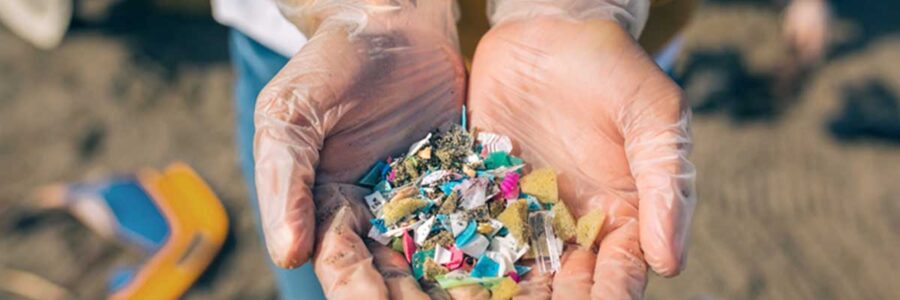Microplastics, a term that should invoke environmental concerns, have become an issue of paramount importance. Recent studies have unearthed startling discoveries: these minute plastic particles contaminate our oceans and food and infiltrate our very bodies, including our hearts.[1]
With mounting evidence of their presence in our innermost tissues, the question now is: How can we mitigate our exposure and ingestion of these microscopic invaders? This article aims to shed light on microplastics, their potential risks, and concrete measures to curtail our exposure and detox from microplastics.
Understanding Microplastics
Microplastics serve as miniature ambassadors of our plastic-dependent society.[2] These are plastic fragments measuring less than 5 millimeters, roughly equivalent to the diameter of a pencil eraser. Despite their diminutive size, their ubiquity in the environment is disconcerting.
The sources of microplastics are multifaceted: they can result from the disintegration of larger plastic items, be intentionally manufactured for use in cosmetics and personal care products, or emerge from the deterioration of synthetic textiles and tires.[2] Once released into the environment, they endure, becoming integrated into our food chain and, as recent research indicates, a potential human health concern.
Why Microplastics Are a Concern
The pervasiveness of microplastics is unsettling, but their potential health ramifications amplify these concerns. As microplastics enter our bodies through consumption, ingestion, or inhalation, they carry potentially detrimental substances. These minuscule fragments can adsorb and transport toxins, heavy metals, and harmful chemicals, effectively carrying these hazardous compounds.[3]
Furthermore, the true peril lies in the unknown. Research into the long-term effects of microplastics on human health is still in its infancy. Initial studies have hinted at potential disruptions to the endocrine system and a potential association with inflammatory reactions.[4] The recent discovery of microplastics in heart tissues underscores how much remains undiscovered regarding their journey inside our bodies and their subsequent effects.
Common Sources of Microplastics in Daily Life
In our daily lives, we often unwittingly invite these invisible intruders into our bodies. Recognizing the most prevalent sources of microplastics is the first step in reducing our exposure.
Food and Water:[5]
- Seafood: Shellfish, particularly filter feeders, accumulate microplastics from their surroundings. Saltwater fish can also ingest these particles, mistaking them for food.
- Salt: Some brands of salt harvested from seawater have been found to contain microplastics.
- Bottled Water: Plastics from the bottles can leach into the water, especially when exposed to heat.
Cosmetics and Personal Care Products:[6]
- Microbeads: These tiny plastic spheres, once common in exfoliating face washes and certain toothpaste brands, directly contribute to microplastic contamination.
- Makeup: Some makeup products, especially glitter ones, may contain tiny plastic particles.
Home Environment:[7]
- Synthetic Textiles: Washing synthetic clothing releases thousands of microfibers into the water.
- Household Dust: The wear and tear of plastic-based household items, from toys to furniture, can contribute to dust laden with microplastics.
Strategies to Reduce Microplastic Ingestion and Exposure
Awareness is pivotal, and once we comprehend the origins of microplastics, we can implement strategies to limit our exposure.
Dietary Choices:
- Freshwater Fish: opt for freshwater species over saltwater ones to reduce microplastic ingestion.
- Minimize Processed Foods: Processed foods’ packaging often sheds microplastics.
- Filtered Water: Employ high-quality water filters to trap microplastics and decrease ingestion.
Household Tips:
- Regular Cleaning: Frequent vacuuming and dusting can diminish exposure to microplastic particles.
- Natural Fibers: Choose natural textiles like cotton or wool over synthetic ones to reduce the release of microfibers into the environment.
- Product Vigilance: Scrutinize the ingredient lists of cosmetics for microplastics or opt for natural, eco-friendly brands.
Medical Awareness:
- Stay Informed: Understand potential sources of exposure, including recent revelations about medical procedures, to make informed choices.
- Seek Alternatives: Discuss potential risks with healthcare providers and inquire about alternative materials or methods where feasible.
Summary
The revelation of microplastics within our bodies underscores the intimate connection between our environment and health, as a stark reminder of the ecological challenges of our era. Although the complete eradication of microplastics may appear daunting due to their widespread presence, the outlined steps offer a practical pathway to reduce our exposure.
By making informed decisions in our daily lives, advocating for systemic change, and supporting sustainable innovations, each of us can contribute to a collective effort to secure a healthier future for ourselves and our planet.
References:
- American Chemical Society. “Microplastics Found in Human Heart Tissues, Both before and after Surgical Procedures.” www.acs.org/pressroom/presspacs/2023/august/microplastics-found-in-human-heart-tissues-before-and-after-surgical-procedures.html.
- American Chemical Society. “Plastic, (Micro)Plastic Everywhere. What Does It Do and Why Should We Care?” www.acs.org/pressroom/tiny-matters/plastic-micro-plastic-everywhere-what-does-it-do-and-why-should-we-care.html.
- Lee, Yongjin et al. “Health Effects of Microplastic Exposures: Current Issues and Perspectives in South Korea.” Yonsei Medical Journal, vol. 64, no. 5, 2023, pp. 301-308.
- Campanale, Claudia et al. “A Detailed Review Study on Potential Effects of Microplastics and Additives of Concern on Human Health.” International Journal of Environmental Research and Public Health, vol. 17, no. 4, 2020, p. 1212.
- Smith, Madeleine et al. “Microplastics in Seafood and the Implications for Human Health.” Current Environmental Health Reports, vol. 5, no. 3, 2018, pp. 375-386.
- US Department of Commerce, National Oceanic and Atmospheric Administration. “What Are Microplastics?” NOAA’s National Ocean Service, 13 Apr. 2016, oceanservice.noaa.gov/facts/microplastics.html.
- “Your Laundry Sheds Harmful Microfibers. Here’s What You Can Do About It.” The New York Times, 21 Apr. 2021, www.nytimes.com/wirecutter/blog/reduce-laundry-microfiber-pollution/.


